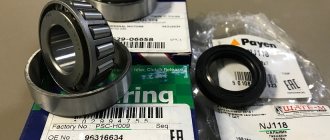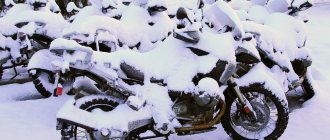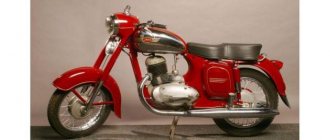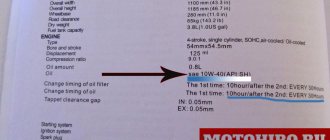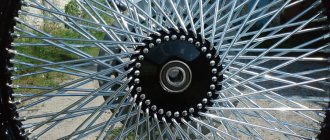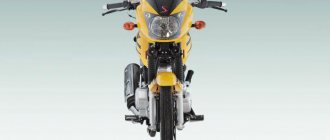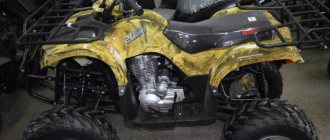Additional equipment for motorcycle
Not all motorcyclists can accept the fact that their steel horse cannot cope with real off-road conditions.
And that’s right, why put up with something when special devices have now been invented that turn the bike into a real all-terrain vehicle .
Today we will talk about how to upgrade your motorcycle for winter use.
Why does a motorcycle need a caterpillar?
By installing tracks on a motorcycle, an enduro enthusiast gets an all-terrain vehicle.
It cannot be said that such an upgrade will turn the bike into a vehicle with maximum cross-country ability.
But as snow test drives show, a motorcycle with tracks is superior to a snowmobile in maneuverability .
Long and wide tracks provide stability to the snowmobile, since the contact patch with the snow surface is quite large.
A similar invention appeared during the Second World War. Then the military installed a bulky structure on the motorcycle, which turned the motorcycle into a real tank.
The type of track that is installed on motorcycles is much narrower and shorter - these factors limit the range of movement.
But there is also a plus here - due to its smaller size, the tracked bike is endowed with increased maneuverability .
Having installed the tracks, the motorcyclist will be able to perform new off-road maneuvers:
- You can take turns with this design practically lying down;
- You can move along a steep slope with a large roll, without fear of capsizing.
As a result, the owner receives a universal bike that can cope not only with snow, but also with mud.
The collision of theory with life
So, it is traditionally not customary to ride an iron horse in the cold season. But riding a bicycle in winter is also not recommended. Regarding the latter, we can safely say that the popular opinion about winter skiing is completely wrong. In winter you can enjoy both cycling and e-biking.
When it comes to a motorcycle or moped, the situation changes. If a cyclist primarily moves along sidewalks or bike paths, then the motorcyclist is a full-fledged participant in the movement. The situation on the city's roads in winter is already tense enough to make it even worse. Such an environment is, without exaggeration, dangerous for a biker. The very weight of the motorcyclist here plays against his driver. Of course, competent work with weight allows you to often get out of difficult situations, but without experience this will be a big problem.
Also, the surrounding weather environment has a strong impact. It becomes noticeably cold even in late autumn, when the temperature does not yet exceed zero. In winter, moving around is also completely uncomfortable.
Kits for motorcycles
If the tracked installation on the rear wheel improves all-terrain qualities, then the kit kit, consisting of a ski and a track, is aimed at operation in winter conditions with abundant snow .
The kit kit for motocross/enduro motorcycles was invented by enthusiasts from the States.
Buying a snowmobile is an expensive pleasure, so extreme sports enthusiasts have found a way to upgrade a motorcycle to get even more drive.
It all started with replacing the front wheel with a ski, and the rear wheel with a caterpillar.
A kit called Explorer is very popular.
The system has won over motorcyclists with its simplicity and reliability: you can replace the wheels with snow elements in a regular box.
But two components will not be enough for a set , right? The set includes special adapters, a drive wheel for the track and other additional elements.
In addition to installing minor parts, you will also have to work on the chain : when changing to a snow version, it must be passed through several sprockets, instead of one.
The brake is removed from the wheel and mounted in the drive wheel of the kit.
The average height of the track profile, depending on the kit, is 3-5 cm. For driving on snowy roads, this “clearance” should be enough .
The system also has its own peculiarities: the caterpillar and ski will feel better in soft and deep snowdrifts ; on hard embankments the caterpillar will often slip.
This problem can be overcome by adjusting the track. You can also simply learn to avoid slipping: before a snowdrift, you should lean back in the saddle .
Shifting weight to the rear axle usually solves the problem and the bike slides further.
Don’t know what parameters you can use to select a caterpillar for a snowmobile? Then check out our article, which contains more than just that.
Maximum reliability and affordable price make this snowmobile very popular in our country.
Transport for Russian open spaces. Snow motorcycles
Home » Controversial history » Transport for Russian open spaces. Snow motorcycles
Controversial historyControversial history of the recent past
byakin 12/14/2011 207 0 comments
0
in Favoritesin Favoritesfrom Favorites 0
In addition to snowmobiles with high-power motors, in domestic conditions it was relevant to create light (single or double) snowmobiles as an individual vehicle capable of replacing motorcycles in winter use. At the same time, work was carried out in several directions: snowmobiles of a special design with a propulsion unit interacting with the track; all-terrain devices for motorcycles and light snowmobiles.
Initially, the designers' efforts were aimed at creating off-road devices for motorcycles. Additional skis on wheels or lateral stability skis, which increase cross-country ability extremely slightly, have gained limited popularity. All kinds of replaceable caterpillar tracks and other devices have shown to be unacceptable due to structural complexity, bulkiness and unsatisfactory cross-country ability 1.
Specially designed snowmobiles required the use of complex transmissions, were labor-intensive to manufacture and metal-intensive, which, given the decline of domestic industry in the 1920s, was difficult. made their development and construction, even in prototypes, a very difficult task.
Snowmobiles have become the most appropriate and popular transport in specific domestic conditions - aircraft of an aviation class, structurally complex and requiring high-quality structural materials. However, the simplest light-duty snowmobiles could be made using available materials. Similar designs were created by individual enthusiasts, but the question of mass construction of light snowmobiles was raised only in 1929.
In the spring of 1929, Avtodor held a competition for designs of low-power snowmobiles suitable for production by grassroots cells with a weak material base. The terms of the competition specifically stipulated the use of wood as the main material for the manufacture of the body.
15 designs were submitted to the competition: Shishkin and Valedinsky, Sme-kalov, VAMB (V. Tsvetkova, A. Skvortsov, M. Veselovsky, B. Belyanin), Zotov, Zharnylsky, Raspopov, Toropov, Verzilov, Elagin, Alekseev, Seleznev, Rozanov and Evensen, Maslov, Shirev and Hartwig.
The most technically advanced design of them, of course, was the F.M. snowmobile. Maslov, issued in two copies at military warehouse No. 94 of the Siberian Military District with the support of local branches of Osoaviakhim, Avtodor and the full assistance of the district leadership in the person of its commander, Comrade Kuibyshev. The snowmobiles, which had minor external differences, also received their own names - M-1 “Avtodorovets” and M-2 “Osoaviakhimovets”.
Snowmobile frame F.M. Maslova was made of wood (the material for the frames was the backs of Viennese chairs), and the lining was made of corrugated chain mail. Snowmobiles M-1 and M-2, equipped with motorcycle engines, had high performance parameters, in particular, reliability, which was confirmed during the successful Omsk-Novosibirsk run. Subsequently, they participated in various reviews and maneuvers. In 1934, during regular maneuvers, the M-1 snowmobile burned out, but the second machine was in operation at least until 1936.
Despite a number of positive qualities, Maslov’s snowmobiles were awarded only an incentive prize, as they did not meet the conditions of the competition, i.e. were unsuitable for construction by grassroots cells and required the use of scarce materials. In 1938 F.M. Maslov built another snowmobile with a motorcycle engine, which differed from previous models in the dimensions and architecture of the body, in particular, the presence of a closed cabin.
The snowmobiles of P.F. were also awarded an honorable mention. Toropov, buildings of the Dynamo society of Ivanovo-Voznesensk and VAMB, collected in Nizhny Novgorod.
The conditions of the competition most fully met the designs of snowmobiles by Shishkin and Valedinsky, who were awarded the first prize, and Raspopov, who received the second prize. The remaining designs, for various reasons, did not receive positive assessments from the commission. The results of the 1929 competition were widely covered in the press, and the drawings of Shishkin and Valedinsky's snowmobiles were published by Avtodor for distribution to the regions at a price of 15 rubles per set.
In February 1932, during the run Moscow - Noginsk - Orekhovo-Zuevo - Yegoryevsk - Kolomna - Moscow, the A-1 snowmobile designed by SV was tested. Korosty-left in ZiMVT. They had a gauge of 1300 mm, a length of 3755 mm, a base of 2055 mm and were equipped with a Blackburn engine with 18 hp. with a propeller with a diameter of 1300 mm. The tests were successful, and the modified A-1s with the NAMI-1 engine under the brand name A-4 (OSGA-4) were accepted for serial construction at the OSGA
“for the purpose of using NKSvyaz for servicing letter carriers in the village and for servicing the super-impact construction of Balkhashstroy”2.
The A-4 snowmobile had an extremely simple, even primitive design, suitable for construction by collective farm workshops or even individual enthusiasts. For their manufacture, a unique version of the plaz-template method was used. A drawing of the side section was made on a sheet of plywood, then a frame was assembled on any horizontal flat surface (even on the floor of the room), to which the sheathing was attached. Then, using frames and struts, the side sections were fastened into the body of the snowmobile. The graceful shape of the snowmobile with slightly convex sides was achieved by slightly bending the side sections during assembly due to the greater width of the frames in the middle part of the machine body.
The snowmobile had a simple suspension with rubber cord shock absorbers. The snowmobile was controlled by a cable, which made it possible, despite the relatively rough design, to avoid backlash and provide the necessary adjustment. The front suspension required a small number of low-quality steel pipes and a minimum of welding. There was almost no need for milling and turning work, since, if necessary, all parts of the snowmobile could be made by hand. In fact, the only structurally complex element of the snowmobile was the propeller. The service life of the snowmobile was determined by the quality of the assembly and the construction materials used.
In the pre-war period, I.N. Yuvenalyev in the Central Automobile and Motorcycle Club of the Soviet Union (TsAMKSS) published a technical description of OSGA-4, which made it possible to build them locally. The number of snowmobiles made in this way cannot even be approximately counted.
After the start of the war with Germany, the issue of building, in addition to combat and transport snowmobiles, also light snowmobiles with motorcycle engines was considered.
In October 1941, the head of the 7th Directorate of the GABTU, military engineer 1st rank Smirnov, approved the TTT for light snowmobiles. Among other things, it was planned to install a machine gun with ammunition and a supply of grenades on a single snowmobile with a motorcycle engine. It was stated that
“The location of the driver’s seat, control pedals and weapons must be designed so that the driver, while moving, can monitor the terrain ahead, control the sleigh and fire, if necessary, both on the move and from a standstill.”
The development of snowmobiles was entrusted to the OKB NKRF; later, NAMI, TsKB GSDP, the Academy of BTiMV and the Irbit Motor Plant became involved in the topic of light snowmobiles. OKB NKRF was faced with a very difficult task - to create a light snowmobile with the same weapons as heavy vehicles, and with a comparable range.
Work on the creation of light snowmobiles, designated RF-7, was divided into two main stages: the creation of a propeller-motor group (VMG) and the design of the snowmobile itself. It was planned to install a multi-speed M-72 engine, but in this case direct landing of the propeller on the crankshaft was excluded, so a gearbox was used. At the same time, in order to reduce weight, the gearbox, clutch and flywheel were removed. The gears used as transmission were internal gears, which fit well into the crankcase. Gasoline was supplied under pressure.
The body of the snowmobile was made of wood, with a set of spars, frames and plywood sheathing. Suspension - four-ski. Ski boars are spring-type, with longitudinal springs 3 . The suspension axles are wooden. Ski brakes are pin-type on the rear skis. The front skis were made controllable.
When testing the VMG, significant vibrations from inertial loads were observed, caused by the low processing accuracy of the transmission gears. Due to the use of internal gearing, it was necessary to abandon the grinding of the teeth; in addition, the gears had uneven play, although they were manufactured at the Machine Tool Plant. Backlash and poor surface finish of the gears caused significant vibrations of the structure, aggravated by the absence of a flywheel, so during the tests five motor shaft failures occurred. The supply of fuel under pressure also turned out to be unsuccessful, as there was an overflow of gasoline.
At the same time, the driving performance of the RF-7 snowmobile was considered satisfactory. During the test on March 8, 1942, at a temperature of - GS with a load of two people, the snowmobiles moved freely on virgin forest land.
Operation of the RF-7 in the winter of 1941 -1942. showed that in conditions of a weak production base the existing VMG design is unacceptable. The engine carburetor did not allow fuel to be supplied under pressure. By January 1943, a drive from the motor to the propeller using a motorcycle chain was designed and installed. A flywheel and a spring elastic coupling were placed on the motor shaft. The fuel supply was now carried out by gravity. The improved power plant was first tested on the RF-7 snowmobile, and in the summer it was tested on a glider. As a result of the measures taken, the operation of the VMG has become significantly more stable.
Although, after modification, the RF-7 snowmobile generally complied with the technical specifications of the GABTU, the OKB NKRF came to the conclusion that traditional design schemes and solutions for the construction of low-power snowmobiles were unacceptable. The main principles in creating the new snowmobile, called the RF-12, were weight reduction and the search for a new design scheme.
The new snowmobiles were distinguished by an open seat for the crew (like on a motorcycle), a motorcycle steering wheel with all control units placed on it, non-deficient construction materials, and a three-ski design while maintaining two tracks. The simplest manufacturing technology and available construction materials made the construction of snowmobiles of this type possible even at a poorly equipped repair facility. Even externally, the RF-12 snowmobile looked like a motorcycle with a sidecar mounted on skis. This similarity intensified when skis were replaced with wheels in the summer.
Preserving two tracks with three skis made it possible to combine the advantages of four- and three-ski snowmobiles. The two skis on the left laid the same track, which significantly reduced the resistance to movement. The absence of the fourth ski and associated suspension and control parts made it possible to significantly reduce the weight of the structure. The track was adopted equal to that of the mass-produced snowmobiles NKL-16, which made it possible to use the RF-12 in the same column with transport snowmobiles.
The RF-12 double, three-ski, and two-track snowmobiles were built in March 1943 in the workshops of the Gorky Institute of Water Transport Engineers according to the design of the OKB NKRF. However, the relatively early spring of 1943 did not allow for comprehensive testing. To check the strength of the structure, the machine was installed on wheels. In this form, it was tested from April to May 1943. Subsequently, the RF-12 made a run on wheels to Moscow and back.
After a series of tests and meetings, the RF-12 snowmobile was recommended for serial production at river fleet repair facilities. In particular, the plan for the production of these snowmobiles for the needs of the Upper Volga River Shipping Company was 10 copies. At the same time, drawings and descriptions of the RF-12 were repeatedly published in the open press, which made it possible to manufacture them by individual enthusiasts. Therefore, the number of snowmobiles of the RF-12 type built cannot be determined even approximately.
In addition to the OKB NKRF, in the period 1941-1945. A number of organizations built several prototypes of light snowmobiles and snowmobiles with motorcycle engines.
At the Academy of BT and MB, Major S.V. Forstep designed the "Winter Machine Gun" snowmobile. They were made in two copies. The main difference of the first copy of the ZP-1 was the use of a screw in a ring (sometimes the device is called a nozzle), which made it possible to significantly increase the thrust of the screw. The disadvantage of this design solution was that installing the screw in the ring required careful manufacturing execution. Due to vibrations of the power plant, aggravated by shock loads when driving off-road, the device was deformed, and the propeller blades could touch the fence.
This forced (with the impossibility of high-quality assembly and adjustment and the use of available cheap materials) to increase the internal diameter of the nozzle or reduce the diameter of the propeller, which made the device ineffective. Therefore, the second sample of the ZP-2 snowmobile had a VMG of a traditional layout. Another interesting feature of the “Winter Machine Gun Carrier” was the ability to control the snowmobile in a prone position, which was supposed to provide maximum protection for the driver from enemy fire when using the simplest type of armor. However, due to a combination of a number of defects, these snowmobiles were not used by the troops.
Also, the sanitary snowmobile of the NAMI design and the snowmobile of the Irbit plant were not widespread, as they showed unsatisfactory parameters of reliability and cross-country ability.
The NAMI MS-1 snowmobile (motor sleigh) was built according to the design of B. Shishkin according to the motor sleigh design of the inventor Kupriyanov, implemented in a prototype back in the 1920s. Among the features of these motor sleighs, one can note the use of the so-called “Nezhdanovsky propulsion device”. For use on virgin snow, this propulsion device was theoretically flawless, but all attempts at its practical implementation invariably failed. The NAMI snowmobile was no exception.
The fate of the light connected snowmobile NKL-34 was somewhat more successful. They were designed at the Central Design Bureau of the GSDP (formerly OKB-41) in 1942 as part of the implementation of scientific and production themes No. 9 and No. 11 of the design bureau’s work plan, which included drawing up a project for the simplest snowmobiles on the instructions of the GABTU.
NKL-34, like RF-7, had a four-ski design. However, the leading designer of NKL-34, Yu.K. Bartashevich (one of the first in domestic practice) used a torsion bar suspension on snowmobiles, which made it possible to significantly reduce their weight and dimensions. Another feature of the snowmobile was the location of the motor in the lower part of the body and the use of a belt drive to the propeller, which significantly increased the stability of the machine. On the sample tested at the GABTU test site, skis of a special design were used, which did not exclude the possibility of installing conventional cross-country skis weighing 80 kg on snowmobiles during mass construction. By 1944, the design bureau produced five NKL-34 snowmobiles.
- Currently, some foreign companies produce replacement caterpillar tracks and skis for motorcycles. They are great for sporting and recreational purposes, allowing you to expand the scope of use of motorcycles, but, being in the same price range as light snowmobiles of a special design, they do not provide comparable cross-country ability.
- Instead of “letter carriers,” the snowmobiles went to the MBO: some OSGA-4 were transferred to the ABT management of the district units, others to the military school of automotive technicians. In total, the OSGA assembled seven snowmobiles of this type.
- The suspension design was similar to the suspension of the 1933 Bombardier snowmobile and the 1934 model snowmobile of the same company.
Source: Alexander Kirindas “TRANSPORT FOR RUSSIAN SPACE.
SNOW MOTORCYCLES» Equipment and Armament 07/2010
Features of design and operation
It’s worth starting the analysis with the caterpillar, it has interesting features:
- Due to the design of the trolley, the caterpillar does not lose traction with the snow - the elastic design promotes constant contact with the surface;
- There is a slight curvature visible in the track frame. This design feature allows you to change the contact area depending on the surface.
- The length of the caterpillar is smaller than the wheel, but the width is about 25 centimeters, which provides increased stability.
The ski that replaces the front wheel only at first glance seems like an ordinary piece of plastic. In fact, it is a functional and durable suspension element .
The ski allows you to deflect the front part by 6 °, but at the same time contact with the surface is not broken.
Another feature is the presence of lateral incisors that bite into the snow . In addition to turns, the tip of the ski can be lowered and raised.
Thanks to these actions, you can cope with any snow conditions.
For example, when overcoming soft snowdrifts, you should lift the ski , then it will not bury itself, and the motorcycle will glide without braking.
In the case of hard surfaces, you need to do the opposite - a lowered toe will provide excellent glide.
Is it forbidden to ride a motorcycle in winter?
There are no restrictions in the traffic rules - until what time you can ride a motorcycle, to what temperature, or visibility. There is no strict ban on operating two-wheeled vehicles on ice or snow. Rules can only limit movement on certain roads, or in the area of signs, regulate the speed of a motorcycle, mandatory equipment and equipment. You can ride motorcycles at any time of the year.
Most motorcyclists who ride pit bikes and small-capacity motocross bikes don’t even ask the question: is it possible to ride a motorcycle in winter, because they simply don’t go to the road. In the forest, across fields, or on a cross-country track - you can ride without restrictions, at any speed and tires.
Estimated cost
Such winter tuning cannot be called cheap .
The price for high-quality kit kits starts from 90 thousand rubles.
The Explorer track and ski will cost 110 thousand rubles, and another 5 thousand will need to be paid for adapters.
Such kits are only suitable for motocross motorcycles whose engines have a displacement of 250 cc or more.
The developers promise to soon release an option for low-power models.
Always be prepared for the weather, terrain, and unforeseen circumstances. Don't forget about the appropriate equipment, some pilots use snowmobile clothing, while others use motocross clothing.
Don’t forget that a tuned bike won’t turn into a snowmobile anyway. You need to be extremely careful, the systems are vulnerable to obstacles in the form of cameos, sticks and stumps, of which there are plenty in the forests.
In appearance, the Sova motorcycle differed from the Voskhod in its more modern design, which could help attract Russian buyers.
And here you will find a review of an equally popular domestic motorcycle
Summarize
Riding a motorcycle in winter is difficult and sometimes dangerous. You need to drive on public roads very carefully and carefully. You shouldn’t even try to achieve the effect of summer movement. If you decide to take a winter trip around the city, do it carefully and in the right lane, and even be as visible as possible to other road users. After all, most drivers never expect to see a motorcyclist in winter! Of course, nothing is impossible, but excessive self-confidence is destructive. In addition, be sure to use all types of protection. You need to be able to feel your iron horse and remember that all its weight is a huge problem in case of uncertainty or if you fall.
If we talk about sport and fun riding in the suburbs, copses or motorcycle trails, there is a lot of freedom for creativity. If there is a lot of snow, then it is better to buy a snowmobile. It handles much more confidently on snowy roads. The motorcycle is more suitable for thaws and mud. You can learn new useful skating skills and tickle your nerves.
Riding in winter is quite possible and this is far from a myth. But using a motorcycle as a full-fledged means of transport is unlikely.
Photo gallery
Off-road motorcycles – motocross and sport-enduro – are vehicles for year-round use. They, unlike other two-wheeled brothers, do not hibernate. In this collection you will find photos of motorcycles of various models with tracks installed on them.
Motor tires
An important nuance of using a motorcycle in winter is the presence of special winter tires. Driving without it is very dangerous! Even if the roads are dry and there is no ice on them, summer tires at low temperatures become hard and grip deteriorates. This leads to the fact that the braking distance increases and the bike begins to “drive” on the road.
As for tires with self-tapping screws or iron spikes screwed into them, these are options for off-road travel, ice or motocross. They are not suitable for driving around the city in winter. What tires are suitable? Soft tires with a deep tread pattern and side studs will provide sufficient grip on the road.
Why can't you use metal studs for city driving? They heat up from friction against the asphalt and melt the tire. In addition, their purpose is to provide traction in extreme conditions. City roads are rarely covered with a thick layer of ice, usually they have a mixture of liquid snow and mud, so rubber “checkers” and low tire pressure are much more effective.
Video
We present to your attention a video.
On it you will see how a cross-country motorcycle on tracks plows the snow-covered mountain expanses, while performing spectacular jumps and turns. It can be seen that professionals manage this easily, despite the fact that the snow is quite deep. Did you like the article? Tell your friends!
Comments (3)
- Geogriy:
03/06/2015 at 09:38For Siberians who live in the snow for half a year, this is at least an interesting upgrade. The only problem is that from the beginning of this year the rules for registering any vehicle tuning have changed. And so far, as far as I know, registration has been suspended altogether. Therefore, how feasible this is is a big question.
Answer
- Vasily Isaev:
03/08/2015 at 10:46
For a winter type of recreation, this is the best means of transportation, especially since a motorcycle does not consume much fuel; at least a tank of gasoline will last for several days; many fans of all-terrain vehicles will be pleased with this.
Answer
- Vladislav Ukhno:
03/09/2015 at 02:12
Interesting solution. Not new, but already embodied in a high-quality, solid, “factory” form. I also saw such an upgrade in some magazine during the USSR: either Young Technician, or, most likely, Model Designer. I think anyone who wants to keep their steel horse in winter will appreciate such a kit, despite the fact that it is not cheap.
Answer
How does a snowbike work?
In our country, snowbikes are still rare, but in the world they are quickly gaining popularity, even separate sports disciplines based on this technique have appeared.
A snowbike is an ordinary enduro or cross motorcycle on which a snow kit is mounted.
The basis of the design is a suspended track and a front ski.
Using special adapters, the kit can be equipped for any cross or enduro. The main requirements are that the engine must be at least 250 cc and the chain drive must be on the left side. The chain transmits torque from the engine drive sprocket to the track gearbox. The track suspension structure is similar to that of a snowmobile.
There is a protective platform above the track. It is used as a trunk. This is very convenient - you can place a canister with a supply of fuel, keys, provisions, etc. on it. everything you need on a trip.
Instead of the front wheel, a ski with a mount is installed, which is made of high-strength material. It glides well and does not wear out, remains flexible and durable in the cold, and easily comes out of loose snow even at low speeds. The geometry of the ski is designed for aggressive maneuvering, like in a snowboard.
Features of riding a motorcycle in winter
Even if you are a beginner, it is not as difficult as it seems. The main thing to remember is a few “golden” rules:
- To “fly” less from a motorcycle or scooter, forget about sudden lane changes, frequent gear changes, and driving in neutral.
- The speed must be kept tight all the time, and braking must be done mainly with the engine.
- If, nevertheless, it is necessary, brake only smoothly, using both mechanisms at once, first, slowing down as completely as possible by releasing the gas.
- Every motorcycle increases its braking distance in winter, so keep the distance two to three times longer than in the rain.
- Equip your motorcycle (moped or scooter) with additional reflective elements.
- Install a more efficient lamp in the main light, hang good fog lights - in winter, in heavy snow, they are more effective.
- Try to drive less in the left lane and be as “predictable” as possible.
Remember that the brakes of the cars in front may be better than yours, and the opposite is true for those behind you, so look in your mirrors more often, and before an intersection, press the rear brake a couple of times without letting it engage. This is enough for the brake light to come on and the person driving behind to react.

